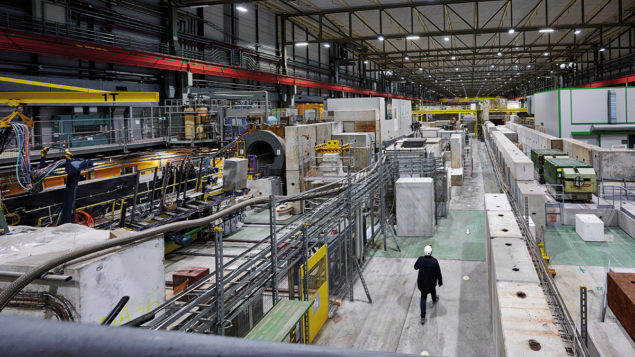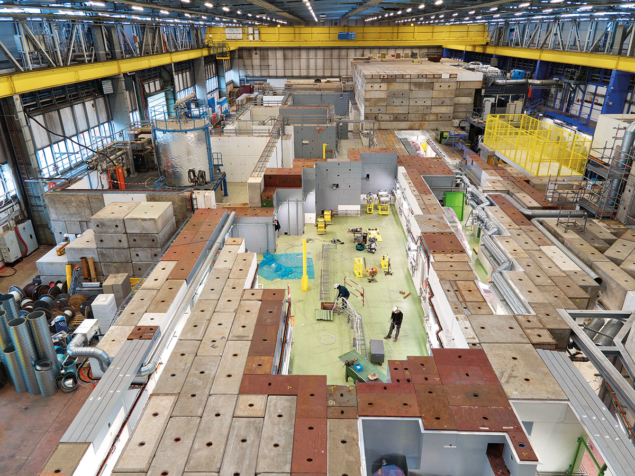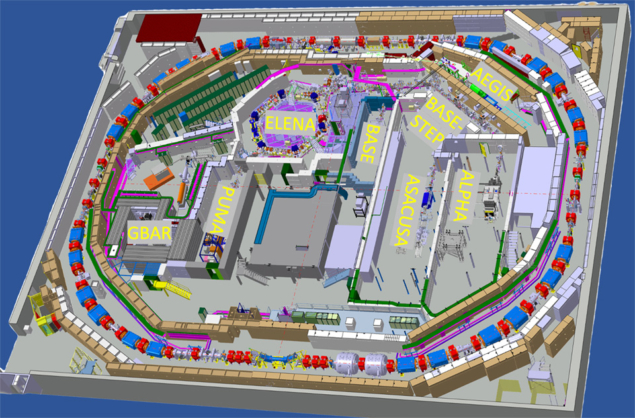
Ultra-relativistic collisions between heavy nuclei probe the high-temperature and high-density limit of the phase diagram of nuclear matter. These collisions create a new state of matter, known as the quark–gluon plasma (QGP), in which quarks and gluons are no longer confined in hadrons but instead behave quasi-freely over a relatively large volume. By creating and studying this novel state of matter, which last existed in the microseconds after the Big Bang, we gain a deeper understanding of the strong nuclear force and quantum chromodynamics (QCD).
Nearly 50 years ago, the first relativistic heavy-ion collision experiments were performed at the Bevatron at Berkeley, reaching energies of 1 to 2 GeV. Since then, heavier ions were collided at higher energies at Brookhaven’s AGS, CERN’s SPS and Brookhaven’s RHIC facilities. Since 2010, heavy-ion physics has entered the TeV regime with lead–lead (PbPb) collisions at 2.76 and 5.02 TeV at the LHC. While the ALICE detector is designed specifically to focus on such collisions, all four large LHC experiments have active heavy-ion physics programmes and are contributing to our understanding of extreme QCD matter.
In a heavy-ion collision, the initial energy deposited by the colliding nuclei undergoes a fast equilibration, within roughly 10–24 s, to form the QGP. The resulting deconfined and thermalised medium expands and cools over the next few 10–24 s, before the quarks and gluons recombine to form a hadron gas. It is the goal of heavy-ion experiments at the LHC to use the detected final-state hadrons to reconstruct the properties and dynamical behaviour of the system throughout its evolution. So far, the LHC experiments have delivered a series of results that are sensitive to various aspects of the heavy-ion collision system, with Run 3 set to push our understanding much further.
Properties and dynamics
The initial energy-density distribution and subsequent expansion of the heavy-ion collision system is largely determined by the geometrical overlap of the colliding nuclei. Collisions can range from head-on “central” collisions, where the nuclear overlap is large, to glancing “peripheral” collisions where the overlap region is smaller and roughly almond-shaped. Since the interaction region in non-central events is not rotationally symmetric, anisotropic pressure gradients build up. These preferentially boost particles along the minor axis of the ellipsoidal overlap region, resulting in an observable anisotropy in the distribution of final-state hadrons. The distribution of the particles in the azimuthal angle can be described well by a Fourier cosine series, where the largest term is the second harmonic, characterised by the parameter v2, due to the ellipsoidal shape of the nuclear overlap region. Fluctuations in the positions of the individual constituent nucleons lead to significant higher-order terms. It was discovered that these Fourier coefficients, vn, are best described by models where the QGP dynamics obeys hydrodynamic equations, and thus behaves as a liquid exhibiting what we call “collective flow”.

Remarkably, in order to fit hydrodynamic models to experimental data it is necessary for the medium’s viscosity to be very low, corresponding to a shear-viscosity to entropy-density ratio of the order η/s ∼ 0.1. With a shear viscosity that is orders of magnitude smaller than other materials, the QGP is known as the “perfect” liquid. Measurements of the higher order harmonics, as well as their event-by-event fluctuations and correlations, provide even greater sensitivity to medium properties and the initial-state dynamics. Precision measurements of the vn harmonics, charged-particle density, mean transverse momentum pT, and mean-pT fluctuations by ALICE have been used to extract the shear and bulk viscosity of the system as a function of temperature (see “Flow coefficients” figure).
While the QGP created in heavy-ion collisions is too small and short-lived to be examined with conventional probes, its properties can be investigated using the products of hard (high momentum-transfer, q2) scatterings that occur in the early stages of the collision and then propagate through the medium as it evolves. The production rates of these internally generated hard probes can be calculated in perturbative QCD and thus are considered calibrated probes of the QGP medium. The high-momentum quarks and gluons produced in these hard scatterings traverse the medium and fragment into collimated jets of hadrons. While these jets appear as a small signal on top of a large, fluctuating background, advances in re-clustering algorithms as well as the higher production rates of jets at the LHC have made it possible to study jets with high precision across a wide range of energies.
The increase in the LHC luminosity will allow us to perform measurements that were previously inaccessible
Compared to jets in proton–proton (pp) collisions, jets in nucleus–nucleus (AA) collisions appear significantly suppressed or “quenched” due to their interactions with the medium (see “Jet quenching” figure). This is in contrast to electroweak probes, which interact only minimally with the coloured QGP medium. When the presence of hard scattering is identified by a high-pT jet, photon or Z boson, the recoiling jet measured in the opposite direction is often reconstructed with a significantly lower energy, indicating that some of its energy has been transferred and absorbed by the medium. Recent, detailed jet-structure studies show that jets in heavy-ion collisions are softer (they fragment into lower-pT hadrons) and broader than their counterparts in pp collisions, due to their interactions with the surrounding coloured QGP medium.
Another class of hard probes are heavy-flavour hadrons, since even heavy quarks (charm and beauty) with low pT are produced in high-q2 processes. Similar to jets, which mainly come from the fragmentation of light quarks and gluons, heavy hadrons are also suppressed in heavy-ion collisions relative to pp collisions. Recent precision measurements at the LHC of the yield of D mesons (containing charm quarks) as well as non-prompt D and J/ψ mesons (from the decays of hadrons containing beauty quarks), compared to the yields in pp collisions, demonstrate a mass-dependent suppression. This observation is consistent with the “dead cone” effect, which predicts that quarks with larger masses will be less significantly suppressed than those with smaller masses. The suppression of quarkonia (quark–antiquark bound states) depends on the binding energy, with loosely bound states such as the Υ(3S) and ψ(2S) more likely to become dissociated in the hot and dense medium than the tightly bound Υ(1S) and J/ψ(1S) states. However, it was discovered at the LHC that final-state J/ψ are actually less suppressed than in lower energy AA collisions at RHIC. This was attributed to the larger number of charm quarks being produced at LHC energies, which enhances the probability that charm and anti-charm quarks can recombine to form J/ψ states within the QGP. These dual effects of suppression and recombination are considered a signature of the production of a deconfined, thermalised medium in heavy-ion collisions.
Freeze out
As the QGP expands and cools, it undergoes a phase transition into a hadron gas in which quarks and gluons become confined into hadrons. At chemical freeze-out, inelastic collisions cease and the thermochemical properties of the system become fixed. Comparing ALICE measurements of the inclusive yields of multiple hadron species with a model of statistical hadronisation shows excellent agreement over nine orders of magnitude in mass, from pions to anti-4He nuclei (see “Statistical production” figure). This indicates that the bulk chemistry of the QGP freeze-out can be described by purely statistical particle production from a system in thermal equilibrium with a common temperature (155 MeV) and volume (~5000 fm3).

One of the first surprising results to come from the LHC was the discovery of azimuthal correlations between particles over large distances in pseudorapidity in small collision systems, pp and pPb. These long-range correlations are observed in heavy-ion collisions, where they are traditionally attributed to anisotropic flow (parameterised by vn coefficients). However, the presence of collective behaviour in small systems, where a QGP was not expected to be formed, raised many questions about our understanding of both large and small nuclear collisions.
A second surprising observation was made in the measurement of the ratios of strange and multistrange hadrons (e.g. K0S, Λ, Ξ and Ω) with respect to pions, as a function of the number of particles produced in the collision (multiplicity). The enhancement of strangeness production in AA compared to pp collisions was historically predicted as a signature of the formation of a QGP, although it is now understood as being due to the suppression of strangeness in small systems. However, measurements by ALICE showed a smooth increase in the strangeness enhancement with multiplicity across all collision systems: pp, pPb, XeXe and PbPb – opening further questions about the presence of a thermalised medium in both small and large systems.
In contrast, the suppression of hard probes, which has long been viewed as a complementary effect to anisotropic flow, has not been observed in pp or pPb collisions within current experimental uncertainties. In order to gain a more complete understanding of QCD from the soft to the hard scales, and from small to large systems, we must expand our experimental programmes.
To Run 3 and beyond
All four large experiments at the LHC have undergone significant upgrades during Long Shutdown 2 to extend their reach and allow the collection of heavy-ion data at higher luminosities. The increase in luminosity by a factor of 10 in Runs 3 and 4 at the LHC will allow us to make precision measurements of soft and hard probes of the QGP. Rare probes such as heavy-flavour hadrons will become accessible with high statistical precision, and we will be able to explore the charm and beauty sector at a level commensurate with that of the strangeness studies in Runs 1 and 2. Jet measurements will become significantly more precise as we further explore the medium-induced modification of well-calibrated probes such as γ– and Z-tagged jets.
Our understanding of collective behaviour and the medium evolution will be enhanced by studies of the correlations and fluctuations of flow coefficients, which provide additional and complementary information above and beyond what we learn from vn alone. Measurements that were severely statistically-limited in Runs 1 and 2, such as those of virtual photons produced as thermal radiation, will be performed with unprecedented precision in Runs 3 and 4. The higher order fluctuations of identified particles, which are expected to be sensitive to critical behaviour around the phase transition, will also come within reach in Runs 3 and 4 and make it possible to map out the phase diagram of QCD matter in great detail.

Furthermore, studies of small systems will continue to shed light on the development of QGP-like signals from pp to AA collisions. In particular, oxygen nuclei will be collided at the LHC, which will allow us to investigate collective effects in collisions with a geometry similar to PbPb collisions but with multiplicities of the order of those in pp and pPb collisions. High-precision and multi-differential jet measurements in pp, pPb and OO collisions will finally allow us to resolve open questions about the relationship between jet quenching and collective behaviour, and whether such effects are observed across all nuclear collision systems. Through these experimental measurements, we will make major progress in our understanding of nuclear matter from small to large collision systems, towards our ultimate goal of a unified description of QCD phenomenology from the microscopic level to the emergent bulk properties of the QGP.
While the heavy-ion physics programme in Runs 3 and 4 will provide deep insights into the rich field of QCD phenomenology, open questions will remain that can only be addressed with further advancements in detector performance and with the significant increase in heavy-ion luminosity anticipated in Run 5 (expected in 2035–2038). This extension of the LHC heavy-ion programme through the 2030s has been supported by the 2020 update of the European strategy for particle physics, and the LHC-experiment collaborations are exploring the potential for novel measurements in light- and heavy-ion collision systems based on their planned detector upgrades. In particular, ALICE is proposing to build a new dedicated heavy-ion experiment, ALICE 3, based on a large-acceptance ultra-light (low material budget) silicon tracking system surrounded by multiple layers of particle identification technology. The increase in the LHC luminosity coupled with state-of-the-art detector upgrades will allow us to dramatically extend our experimental reach and perform measurements that were previously inaccessible. The goals of the future heavy-ion programme at the LHC – from measuring electromagnetic radiation from the QGP and exotic heavy-flavour hadrons to beyond-the-Standard-Model searches for axions – will provide unprecedented insight into the fundamental constituents and forces of nature.

















 Pantaleo Raimondi, professor at the Stanford Linear Accelerator Center, research technical manager, SLAC National Accelerator Laboratory and previously director, Accelerator and Source Division, ESRF.
Pantaleo Raimondi, professor at the Stanford Linear Accelerator Center, research technical manager, SLAC National Accelerator Laboratory and previously director, Accelerator and Source Division, ESRF.

